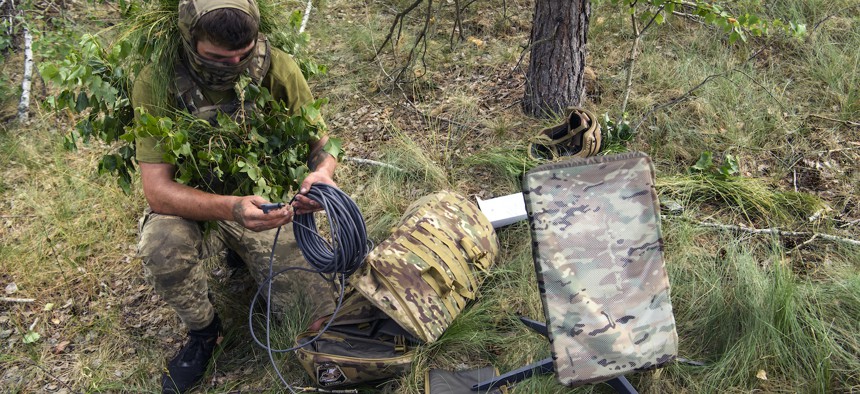
A Ukrainian soldier of the 61st Separate Mechanized Brigade uses the Starlink system during military exercises in the Chernihiv region, Ukraine, June 2023. Maxym Marusenko / NurPhoto via Getty Images
Defense Business Brief: Kendall on Starlink; TRANSCOM advisors on commercial ships; Pratt to improve C-17 engines; and more.
Now that Elon Musk has acknowledged withholding satellite internet service to Ukraine, the U.S. Air Force secretary said the military needs commercial services available.
“If we're going to rely upon commercial architectures or commercial systems for operational use, then we have to have some assurances that they're going to be available, and there are different ways we can get there,” Air Force Secretary Frank Kendall said during a Monday afternoon briefing at the Air & Space Forces Association’s annual Air, Space, Cyber conference.
“We have to have that,” he said. “Otherwise they’re a convenience and maybe an economy in peacetime, but they're not something we can rely upon in wartime. And we need both.”
Ukraine’s military has relied on Musk’s SpaceX Starlink satellite internet for military command and control since Russia invaded in February 2022. The U.S. military and its allies routinely rely on commercial services in wartime. Musk disabling Starlink access reportedly prevented Ukrainian forces from attacking Russian warships in Crimea last year.
Kendall, who oversees both the Air Force and the Space Force, said talked with Space Systems Command, which manages the Space Force’s relationships with commercial space firms.
Welcome
You’ve reached the Defense Business Brief by Marcus Weisgerber. Special thanks to Audrey Decker for lots of help with this week’s edition. If you’re at AFA, make sure you say hello if you see us running around. Send along your tips, and feedback to mweisgerber@defenseone.com or @MarcusReports. Check out the Defense Business Brief archive here, and tell your friends to subscribe!
The Air Force is still hopeful the B-21 stealth bomber, which was unveiled last year, will fly before the end of this year. “We're going through a number of things to get ready for first flight,” Kendall said. “They all have to happen and there is always risk in development programs—something can surprise you.”
Last year, Gen. Jacqueline Van Ovost, the head of U.S. Transportation Command, talked about sharing more intelligence with commercial air and sea carriers. Now it’s happening. Before Russia invaded Ukraine, TRANSCOM gave a classified threat briefing to its commercial carriers. More recently, the command provided a similar briefing to shipping companies operating in the Gulf near Iran, Van Ovost said.
TRANCOM has trained 275 tactical advisors, who are already riding on ships in high-threat locations like the Strait of Hormuz. The advisors can share information about threats in the area and call for help if needed, Van Ovost said.
In addition, TRANCOM has partnered with the Cybersecurity and Infrastructure Security Agency, or CISA, to help cargo airlines and sea carriers make sure their computer networks are protected.
“it's really important that those manifests, and the scheduling be protected,” she said.
Airlines and commercial shipping carriers have delivered about 75 percent of the weapons that have been sent to Ukraine, Van Ovost said.
A Pratt & Whitney-run engine performance improvement package for its C-17 F117 engines will save the Air Force approximately $29 million in reduced fuel costs and reduce the need for 6.5 million gallons of fuel annually, according to company executives. The improvement package, which includes tech developed for the company’s commercial engine products, was part of a $5.5 billion F117 sustainment contract the Air Force awarded to Pratt in June.
“Over the course of this contract, we're going to take known technology that has been proven out in other commercial applications, we're going to do the basic work required to enable it to apply to the F1 17 engine,” Chris Johnson, the company’s vice president of fighter and mobility programs said during a Monday briefing at AFA.
“It is going to create better fuel burn and it's going to extend the time on wing—the time in between shop visits,” Johnson said.
Fewer trips to the shop means that more planes will be available at any given time.
LightRidge Solutions’ Geost will build a resiliency payload for Northrop Grumman’s Tracking Layer Tranche 1 satellites being developed for the Space Development Agency. The satellites are scheduled to launch in 2025.
Boeing will convert an MD-90 into an experimental aircraft with a new transonic truss-braced wing, the company announced. The plane will be part of a NASA-led effort to reduce greenhouse gas emissions. “With ultrathin wings braced by struts with larger spans and higher-aspect ratios, the TTBW design and other expected technological advances could lead to reductions in fuel use and emissions by up to 30%,” Boeing said. Concept images show the plane’s aft-fuselage-mounted engines removed and new engines mounted under the wings.
Saab has completed its acquisition of Silicon Valley-based CrowdAI. “Saab’s capabilities are enhanced through proactive acquisitions and strategic partnerships in emerging and disruptive technologies such as” artificial intelligence and machine learning, the company said.
Bonus: Anduril completed its acquisition of Blue Force Technologies, maker of the Fury drone, which is on display in the exhibit hall at AFA. Of note: The Virginia-based McLean Group served as financial adviser to Blue Force Technologies on this acquisition.
Bell has chosen GE Aerospace to develop the Common Open Architecture Digital Backbone, voice and data recorder, and health awareness system for the V-280 tiltrotor the Army chose late last year to replace Black Hawk helicopters.
Making Moves
- SkyGrid announced that Jia Xu has been appointed CEO and will succeed Amir Husain, who will remain board member.
- President Biden has nominated Air Force Lt. Gen. James Slife for a fourth star and to become the Air Force vice chief of staff.
- Leidos announced Amy Smith will be promoted to senior vice president of government affairs.
NEXT STORY: Conference Wire: Air, Space & Cyber 2023, Day 1





